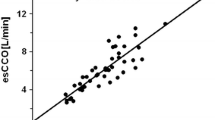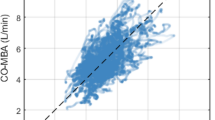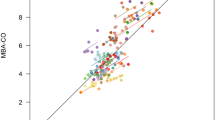Abstract
Purpose
A continuous cardiac output monitor based on arterial pressure waveform (FloTrac™/Vigileo™; Edwards Lifesciences, Irvine, CA) is now approved for use in adults but not in children. This device is minimally invasive, calculates cardiac output continuously and in real time, and is easy to use. Our study sought to validate the FloTrac™ with the pulmonary artery catheter (PAC) intermittent thermodilution technique in pediatric cardiac patients.
Methods
This was a prospective pilot study comparing cardiac output measurements obtained via the FloTrac™ and arterial pressure waveform analysis with intermittent thermodilution. Subjects carried the diagnosis of pulmonary hypertension or cardiomyopathy, or were in the postoperative course after orthotopic heart transplantation.
Results
Enrolled in the study were 31 subjects, and 136 data points were obtained. The age range was 8 months to 16 years. The mean body surface area (BSA) was 1.1 m2. Bland-Altman plots for the mean cardiac outputs of all subjects with a BSA ≥1 m2 showed limits of agreement of −2.7 to 8.0 l/min (±5.4 l/min). Patients with a BSA ≤1 m2 demonstrated even wider limits of agreement (±8.5 l/min). The intraclass correlation for the PAC was 0.929 and 0.992 for the FloTrac™.
Conclusion
There was poor agreement between the PAC and FloTrac™ in measuring cardiac output in a population of children with pulmonary hypertension or cardiomyopathy, or after cardiac transplantation. This is in contrast to adult studies published thus far. This suggests that the utility of the FloTrac™ and measurements obtained from arterial pulse wave analysis in children is uncertain at this time.


Similar content being viewed by others
References
Swan HJ, Ganz W, Forrester J, Marcus H, Diamond G, Chonette D (1970) Catheterization of the heart in man with use of a flow-directed balloon-tipped catheter. N Engl J Med 283:447–451
Connors AF Jr, Speroff T, Dawson NV, Thomas C, Harrell FE Jr, Wagner D, Desbiens N, Goldman L, Wu AW, Califf RM, Fulkerson WJ Jr, Vidaillet H, Broste S, Bellamy P, Lynn J, Knaus WA (1996) The effectiveness of right heart catheterization in the initial care of critically ill patients. SUPPORT Investigators. JAMA 276:889–897
The ESCAPE investigators; ESCAPE Study Coordinators (2005) Evaluation study of congestive heart failure and pulmonary artery catheter effectiveness: the ESCAPE trial. JAMA 294:1625–1633
Harvey S, Harrison DA, Singer M, Ashcroft J, Jones CM, Elbourne D, Brampton W, Williams D, Young D, Rowan K; PAC-Man study collaboration (2005) Assessment of the clinical effectiveness of pulmonary artery catheters in management of patients in intensive care (PAC-Man): a randomised controlled trial. Lancet 366:472–477
Shah MR, Hasselblad V, Stevenson LW, Binanay C, O’Connor CM, Sopko G, Califf RM (2005) Impact of the pulmonary artery catheter in critically ill patients: meta-analysis of randomized clinical trials. JAMA 294:1664–1670
National Heart, Lung, and Blood Institute Acute Respiratory Distress Syndrome (ARDS) Clinical Trials Network; Wheeler AP, Bernard GR, Thompson BT, Schoenfeld D, Wiedemann HP, de Boisblanc B, Connors AF Jr, Hite RD, Harabin AL (2006) Pulmonary-artery versus central venous catheter to guide treatment of acute lung injury. Fluid and Catheter Treatment Trial (FACTT). N Engl J Med 354:2213–2224
Squara P, Cecconi M, Rhodes A, Singer M, Chiche JD (2009) Tracking changes in cardiac output: methodological considerations for the validation of monitoring devices. Intensive Care Med 35:1801–1808
Manecke GR Jr, Auger WR (2007) Cardiac output determination from the arterial pressure wave: clinical testing of a novel algorithm that does not require calibration. J Cardiothorac Vasc Anesth 21:3–7
Mayer J, Boldt J, Schollhorn T, Rohm JD, Menistu AM, Suttner S (2007) Semi-invasive monitoring of cardiac output by a new device using arterial pressure waveform analysis: a comparison with intermittent pulmonary artery thermodilution in patients undergoing cardiac surgery. Br J Anaesth 98:176–182
Opdam HI, Wan L, Bellomo R (2006) A pilot assessment of the FloTrac cardiac output monitoring system. Intensive Care Med 33:344–349
Sander M, Spies CD, Grubitzscj H, Foer A, Muller M, von Heymann C (2006) Comparison of uncalibrated arterial waveform analysis in cardiac surgery patients with thermodilution cardiac output measurements. Crit Care 10:R164
McGee WT, Horswell JL, Calderon J, Janvier G, Van Severen T, Van den Berghe G, Kozikowski L (2007) Validation of a continuous arterial pressure-based cardiac output measurement: a multicenter, prospective clinical trial. Crit Care 11:R105
Saaka SG, Kozieras J, Theumer O, van Hout N (2007) Measurement of cardiac output: a comparison between transpulmonary thermodilution and uncalibrated pulse contour analysis. Br J Anaesth 99:337–342
Della Rocca G, Costa MG, Coccia C, Pompei L, Di Marco P, Vilardi V, Pietropaoli P (2003) Cardiac output monitoring: aortic transpulmonary thermodilution and pulse contour analysis agree with standard thermodilution methods in patients undergoing lung transplantation. Can J Anaesth 50:707–711
Felbinger TW, Reuter DA, Eltzschig HK, Bayerlein J, Goetx AE (2005) Cardiac index measurements during rapid preload changes: a comparison of pulmonary artery thermodilution with arterial pulse contour analysis. J Clin Anesth 17:241–248
Gödje O, Höke K, Goetz AE, Felbinger TW, Reuter DA, Reichart B, Friedl R, Hannekum A, Pfeiffer UJ (2002) Reliability of a new algorithm for continuous cardiac output determination by pulse-contour analysis during haemodynamic instability. Crit Care Med 30:52–58
Halvorsen PS, Espinoza A, Lundblad R, Cvancarova M, Hol PK, Fosse E, Tønnessen TI (2006) Agreement between PiCCO pulse-contour analysis, pulmonal artery thermodilution and transthoracic thermodilution during off-pump coronary artery by-pass surgery. Acta Anaesthesiol Scand 50:1050–1057
Cecconi M, Dawson D, Grounds RM, Rhodes A (2009) Lithium dilution cardiac output measurement in the critically ill patient: determination of precision of the technique. Intensive Care Med 35:498–504
Knirsch W, Kretschmar O, Tomaske M, Stutz K, Nagdyman N, Balmer C, Schmitz A, Bettex D, Berger F, Bauersfeld U, Weiss M (2008) Cardiac output measurement in children: comparison of the ultrasound cardiac output monitor with thermodilution cardiac output measurement. Intensive Care Med 34:1060–1064
Notterman DA, Castello FV, Steinberg C, Greenwald BM, O’Loughlin JE, Gold JP (1989) A comparison of thermodilution and pulsed Doppler cardiac output measurement in critically ill children. J Pediatr 115:554–560
Kim J, Dreyer J, Chang A (2006) Arterial pulse wave analysis: an accurate means of determining cardiac output in children. Pediatr Crit Care Med 7:532–535
Bland JM, Altman DG (1986) Statistical methods for assessing agreement between two methods of clinical measurement. Lancet i:307–310
Critchley LA, Critchley JA (1999) A meta-analysis of studies using bias and precision statistics to compare cardiac output techniques. J Clin Monit Comput 115:85–91
Barnhart HX, Haber MJ, Lin LI (2007) An overview on agreement with continuous measurements. J Biopharm Stat 17:529–569
Mayer J, Boldt J, Poland R (2009) Continuous arterial pressure waveform-based cardiac output using the FloTrac/Vigileo: a review and meta-analysis. J Cardiothorac Vasc Anesth 23:401–406
Manecke GR (2005) Edward’s FloTrac sensor and Vigileo Monitor: easy, accurate reliable cardiac output assessment using the arterial pulse wave. Expert Rev Med Devices 2:523–527
Button D, Weibel L, Reuthebuch O, Genoni M, Zollinger A, Hofer CK (2007) Clinical evaluation of the FloTrac/Vigileo system and two established continuous cardiac output monitoring devices in patients undergoing cardiac surgery. Br J Anaesth 99:329–336
Calamandrei M, Mirabile L, Muschetta S (2008) Assessment of cardiac output in children: a comparison between the pressure recording analytical method and Doppler echocardiography. Pediatr Crit Care Med 9:310–312
Ronco R, Riquelme C (2008) Cardiac output measurement in children: what is lacking? Pediatr Crit Care Med 9:333–334
Cecconi M, Rhodes A, Poloniecki J, Della Rocca G, Grounds RM (2009) Bench to bedside review: the importance of the precision of the reference technique in method comparison studies – with specific reference to the measurement of cardiac output. Crit Care 13:201–206
Frazier J, Hatib F (2008) “Getting ml/beat from mmHg”. Arterial pressure-based cardiac output: the Edwards FloTrac algorithm. Edwards Lifesciences, Irvine, CA. http://ht.edwards.com/resourcegallery/products/mininvasive/pdfs/flotrac_algorithm.pdf. Accessed 22 May 2011
Acknowledgments
The authors would like to acknowledge Dunbar Ivy MD, Shelley Miyamoto MD and Bill Pietra MD, and the cardiac catheterization laboratory staff for their support.
The authors declare there was neither financial support for this study nor any conflicts of interest with the manufacturer, Edwards Lifesciences, LLC. The authors retained full control of all primary data at all times.
Author information
Authors and Affiliations
Corresponding author
Rights and permissions
About this article
Cite this article
Teng, S., Kaufman, J., Pan, Z. et al. Continuous arterial pressure waveform monitoring in pediatric cardiac transplant, cardiomyopathy and pulmonary hypertension patients. Intensive Care Med 37, 1297–1301 (2011). https://doi.org/10.1007/s00134-011-2252-y
Received:
Accepted:
Published:
Issue Date:
DOI: https://doi.org/10.1007/s00134-011-2252-y




